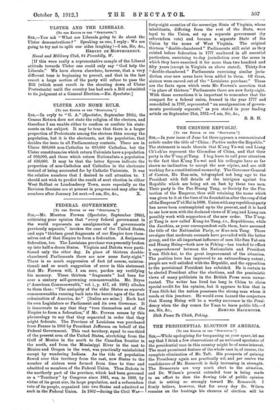FEDERAL GOVERNMENT.
[To THE EDITOR OP THE "SPECTATOR:1 Sin,—Mr. Moreton Frewen (Spectator, September 28th), criticising your opinion that "every federal government in the world represents an amalgamation of governments previously separate," invokes the case of the United States, and says " thirteen great fragments of our Empire tore them- selves out of that Empire to form a federation. A fissiparous federation, too. The Louisiana purchase was presently broken up into half-a-dozen States. Virginia and Dakota were parti- tioned only the other day. In place of thirteen double- chambered Parliaments there are now some forty-eight." There is so much suppression of fact (of course, uninten- tional) and so much suggestion of error in this statement that Mr. Frewen will, I am sure, pardon my rectifying his memory. These thirteen " fragments " had been for over a century self-governing commonwealths. Mr. Bryce ("American Commonwealth," vol. i., p. 417, ed. 1891) alludes to them thus : " The antiquity of the older States as separate commonwealths running back into the heroic ages of the first colonization of America, &c." [Italics are mine.] Each had its own Legislature or Parliament and its own Governor. It is inaccurate to say that they "tore themselves out of the Empire to form a federation," if Mr. Frewen means by this phraseology to say that they separated in order that they might federate. The Province of Louisiana was purchased from France in 1803 by President Jefferson on behalf of the Federal Government. This vast territory, equal to one-third of the present area of the United States, stretching from the Gulf of Mexico in the south to the Canadian frontier in the north, and from the Mississippi River in the east to Mexico and Oregon in the west, was practically uninhabited except by wandering Indians. As the tide of population flowed over this territory from the east, new States to the number of sixteen were formed from time to time and admitted as members of the Federal Union. Thus Dakota in the northerly part of the province, which had been governed as a "Territory" by Congress since 1861, was, in 1889, by virtue of its great size, its large population, and a referendum vote of its people, organized into two States and admitted as such in the Federal Union. In 1862—during the Civil War—
forty-eight counties of the sovereign State of Virginia, whose inhabitants, differing from the rest of the State, were loyal to the Union, set up a separate government (by referendum vote) and became a separate State of the Union by the name of West Virginia. The original thirteen "double-chambered" Parliaments still exist as they existed before federation in 1777 unaltered in all essential particulars, exercising to-day jurisdiction over the areas in which they have exercised it for more than two hundred and fifty years (except in Virginia as above stated). Thirty-five "double-chambered " Parliaments exercising similar juris- diction over new areas have been added to them. Of these, sixteen were carved out of the " Louisiana purchase." These are the facts upon which rests Mr. Frewen's assertion that "in place of thirteen" Parliaments there are now forty-eight. With these corrections it is important to remember that the compact for a federal union, framed in the year 1777 and remodelled in 1787, represented " an amalgamation of govern- ments previously separate," as you stated in your leading article on September 21st, 1912.—I am, Sir, &c., B. R. H.


































































 Previous page
Previous page